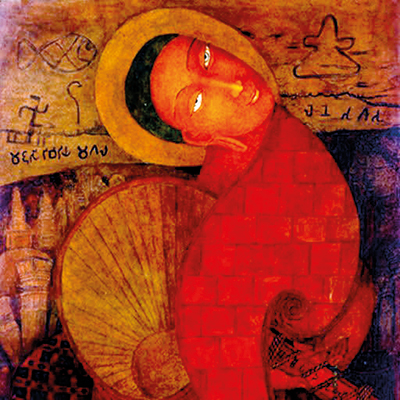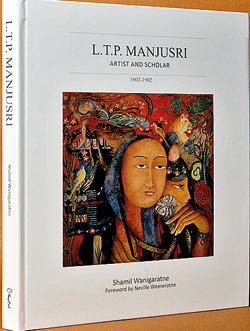A gem-studded tour of an exceptional artist

The monk devotee: One of Manjusri’s Buddhist themed paintings
Most of us art lovers have certainly known of Manjusri. Associating him with temple art, frescos, and murals while not really prepared to delve or dive any deeper. That’s why Shamil Wanigaratne’s gem of a book (or monograph)that covers a gigantic canvas simply exploded in front of me. A riot of colour, fine drawings, draftsman-like detail,soft tones, subtle textures and delicate tints that unfurled Manjusri to be a classic prodigy, a national hero, who contributed enormously to our culture, art and history. Shamil’s brilliantly laid out missile of 240 pages (that took 10 years to produce) has brought on and showcased Manjusri to easily be one of the most versatile artists the world has ever known.
Shamil first meticulously traces, chronicles and narrates the life and times of Manjusri. A timeline and a biography. Early education in a Muslim school in Beruwela! Performing Nadagam and Kolam, apprentice carpenter at 11. An interest in levitation. Joined a Pirivena at 13 and ordained a monk at 19.The same year left for “Shantiniketan” the school of learning set up by Rabindranth Tagore whom he met there and Nandalal Bose who introduced him to the appreciation of art. His journey to Tibet that ended at Gangok in Sikkim and a formal training in art from Abbot Uchima. The Japanese spy incident. A founder member of the 43 Group from which he quickly fled. Student of many languages, life as a journalist, artist, craftsman, friend, exhibiting in London, Vienna and New York, winner of the Ramon Magsaysay Award – Asia’s Nobel Prize, commemoration stamp in his honour…..
 Shamil then gives us a spectacular gem studded tour of the exceptionally wide spectrum of Manjusri’s art. From the temple paintings of the Kandyan era which he copied and preserved, to paintings with Buddhist themes and Tibetan influences. Surrealism to Cubism. Abstract Expressionism to Abstract Symbolic Works. Still Life, Animal Drawings and Paintings and Landscapes. One of my favourites is the enigmatic painting “Artist” (also on the book cover). “The artist is represented only by the hand poised with a paintbrush. Two women, one viewed frontally, the other in profile, occupy the foreground. They are set within a forest populated with a lion, an elephant, birds, a butterfly and a toad, set in a hybrid landscape which includes Persianate-style rock formations and clouds, as well as Japanese inspired cherry blossom, bamboo and other landscape elements. The rich complexity of design elements adds to the painting’s engaging presence”.
Shamil then gives us a spectacular gem studded tour of the exceptionally wide spectrum of Manjusri’s art. From the temple paintings of the Kandyan era which he copied and preserved, to paintings with Buddhist themes and Tibetan influences. Surrealism to Cubism. Abstract Expressionism to Abstract Symbolic Works. Still Life, Animal Drawings and Paintings and Landscapes. One of my favourites is the enigmatic painting “Artist” (also on the book cover). “The artist is represented only by the hand poised with a paintbrush. Two women, one viewed frontally, the other in profile, occupy the foreground. They are set within a forest populated with a lion, an elephant, birds, a butterfly and a toad, set in a hybrid landscape which includes Persianate-style rock formations and clouds, as well as Japanese inspired cherry blossom, bamboo and other landscape elements. The rich complexity of design elements adds to the painting’s engaging presence”.

The author: Shamil Wanigaratne
G.P. Malalasekera’s description of Manjusri’s vast and diverse art is apt and may be a good starting point in trying to understand his oeuvre: “He is full of contrasts, even contradictions. His artistic fecundity and variety are amazing. He is dexterous in the conventionalized and detailed line-work of traditional Indian and Sinhala art as in producing work obviously inspired by the modern exponents of Abstractionism and Surrealism. Nobody can doubt his remarkable ability as a draftsman. He has shown great ability in adapting for his own purposes the lessons to be learnt from the most ‘advanced’ painters from the west without,happily, yielding to imitation as so many of his contemporaries have done… He is skilful in handling soft tones and delicate tints as in the daring juxtaposition of the most varied and most brilliant colours. He is an exponent of all styles without developing a style of his own”.
What captivated me most was that Manjusri was really a simple, gentle, generous, honest, humble human being who could engage (and navigate) easily with anybody he came across during his multi-faceted life. Born in Aluthgama and named L.T. Peiris, nobody knows how he mysteriously acquired the name Manjusri which means “Gentle Glory” in Sanskrit! Manjusri is one of the most important iconic figures in Mahayana Buddhism and is known as the Bodhisattva of Great Wisdom.

The artist: Manjusri
Shamil also generously lends some space to the art of Manjusri’s children Manjista, Mandalika and Kushan who particularly helped him immensely in putting this book together. Copies of paper cuttings that document Manjusri’s articles with sketches and other significant contributions to our cultural history also adorn the book together with very interesting letters written by his many admirers.
Dr. Shamil Wanigaratne is a much sought after Clinical Psychologist and specialist in the field of addiction and mental health capacity building who lives in the UAE while doing a lot of pro bono work in Sri Lanka. In 2000 he published another excellent book to commemorate and introduce the works of George Claessen – a founder member (together with Manjusri) of the 43 Group who many believe heralded the dawn of Modern Art in Sri Lanka. Shamil’s interest, knowledge and love for art is indeed extraordinary. I am sure there will be much better reviews of this wonderful book but I do hope mine will quickly inspire and gently nudge art lovers to take the first step in owning and relishing its valuable contents so lovingly put together.
L.T.P. MANJUSRI – Artist and Scholar (1902-1982) published by Bay Owl Press
is available at leading book stores priced at Rs 7500



